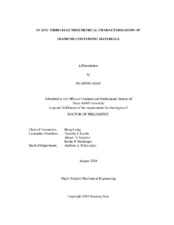| dc.description.abstract | Diamond has been under spotlight in industry since the discovery of its extraordinary mechanical properties, high wear resistance and excellent chemical inertia. These properties enable diamond a competitive candidate for industrial and biomedical applications. In the present research, the tribological properties of two types of diamond materials, diamond reinforced ceramic composites and diamond coatings have been investigated.
Experimental approaches consist of tribological investigation, electrochemical evaluation and characterization of diamond-reinforced ceramic composites (DRCC), thin nanocrystalline diamond (NCD) film, thin microcrystalline diamond (MCD) film and their functionalized derivatives.
After the tribotest, phase transformation from diamond carbon (sp^(3)) to amorphous carbon (sp^(2)) is confirmed by Raman spectroscopy in the diamond composite. The surface roughness of the diamond grits was found to be greatly reduced due to wear. A tribo-electrochemical method is developed to in situ monitor the this amorphrization-wear process. It is discovered that the current density is a function of the excitation voltage in a sinusoidal pattern. The amplitude and period of the sinusoidal pattern reflect the intensity and the frequency of the process. For the diamond-cartilage contact, it is found that the coefficient of friction between cartilage Figure and diamond decreases with increasing load because real contact area is not linearly change with load. Even though the hydrogen treatment decreases the friction and ammonia treatment decreases adhesion and friction in dry conditions, the friction under lubrication is determined by synergy effects of number of bonds established and strength of single bond between protein of the cartilage and the diamond surface.
In the present research, the wear mechanism of diamond-reinforced composite has been demonstrated. The amorphization-wear process of diamond can be real-timely monitored using electrochemical approach. The frication force between diamond surface and human cartilage can be adjusted by changing number of bonds established or strength of single bond between protein of the cartilage and the diamond surface. This research proposes new avenue in the evaluation of friction and wear of diamond materials, which will be beneficial to wide range of diamond applications, including aerospace industries, mechanical processing, biomedical science, prosthetics and energy industries. | en |


